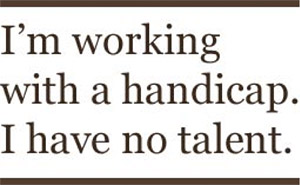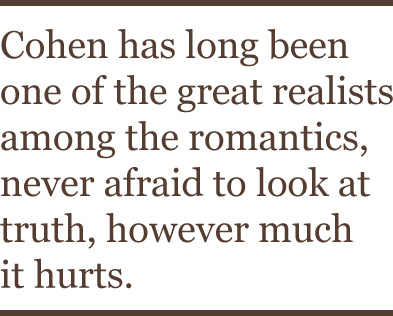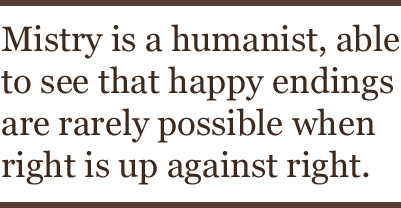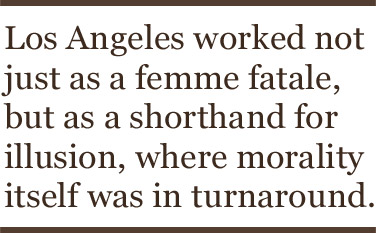The Japan we imagine from afar is placid, tidy and seamlessly efficient, correct to the last place. The trains arrive on the dot, and when the crowds pour out of them, in streamlined rows of look-alike Chanel and grey suits, not a bead of sweat is visible even in the heat of summer rush-hour. Japan has taken the Confucian model of old China and refined it to the digital nth degree; the sense of loyalty to the group is so advanced–and so perfected here–that the country can seem at times like a cult writ large, a capitalist version of Kim Jong Il’s earthly paradise, in which everyone is playing from the same score and everyone knows her part.
There’s truth, without question, to all of this. But what it ignores are the immovable Newtonian rules of engagement. The more rigorously a group mentality is enforced, the wilder the explosions of individual eccentricity. And even a group is made up, often, of separate sects and tribes, each eager at once to enjoy the comforts of being part of a massed force, and the pleasure of imagining themselves individual (original, after a fashion). Japan, in other words, is the spiritual home of fandom. Not just the collective fanaticism we associate with kamikaze pilots and teams of men, company pins on their lapels, tumbling out of buses to buy up our companies (or snap them up on digi-cams at least); but also an individual fandom that–I surprise myself by saying–is more rabid, more passionate and visceral, than anything I have seen in thirty years of visiting Brazilian soccer stadiums and hotels mobbed by Backstreet Boys aficianados.
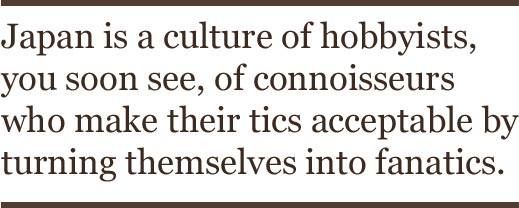 When you walk around a Japanese town, even a city of privacies like the ancient capital of Kyoto (near which I’ve lived now for sixteen years), you pass through what is essentially a series of dream-chambers, custom-made homes for individual fantasies (the love hotel, with its beds made to look like Cadillacs, cavemen’s dens and rocket ships, is not just a product, but a reflection of contemporary Japan). This coffee shop on Sanjo Dori plays only Mozart music, around the clock, for twenty years or more. That honky-tonk in the hills features locals in ten-gallon hats crooning Hank Williams, Jr. standards. This Zen monk I know in Nagoya furnishes his temple with a complete set of CHiPs tapes from American TV, though California Highway Patrolmen have not always been regarded as intrinsic to the dissolution of self. That woman runs an elegant gift shop, near the Temple of Pure Water, in which every item is an owl.
When you walk around a Japanese town, even a city of privacies like the ancient capital of Kyoto (near which I’ve lived now for sixteen years), you pass through what is essentially a series of dream-chambers, custom-made homes for individual fantasies (the love hotel, with its beds made to look like Cadillacs, cavemen’s dens and rocket ships, is not just a product, but a reflection of contemporary Japan). This coffee shop on Sanjo Dori plays only Mozart music, around the clock, for twenty years or more. That honky-tonk in the hills features locals in ten-gallon hats crooning Hank Williams, Jr. standards. This Zen monk I know in Nagoya furnishes his temple with a complete set of CHiPs tapes from American TV, though California Highway Patrolmen have not always been regarded as intrinsic to the dissolution of self. That woman runs an elegant gift shop, near the Temple of Pure Water, in which every item is an owl.
Japan is a culture of hobbyists, you soon see, of connoisseurs who make their tics acceptable by turning themselves into fanatics. It is a place where you soon grow unsurprised to hear that that old man has given his life to following salsa dancing, and that one has got every King Crimson C.D. every released. I sometimes feel, living near Kyoto, as if I am lost in a circuitboard of mad enthusiasms. Four books on Hugh Grant come out before most of us have heard of him in California (and the long-forgotten movie, Bengal Nights, in which Hugh plods around Calcutta speaking with a Romanian accent, acting as the University of Chicago mythographer Mircea Eliade, is featured this month at the local video store). Sobbing middle-aged women devote their lives to following a single actress from the campy, all-female Takarazuka troupe, which puts on unisex, Vegas-worthy productions of Gone with the Wind and other musicals. Over and over people question me earnestly about the popularity and meaning of such American icons (almost unheard-of in America) as Brad Renfro, or Germany’s national goalkeeper, Oliver Kahn..
This rampant fanaticism–the Platonic essence of fandom, it can sometimes seem, in a culture that trafficks in Platonic ideals–comes to a roaring culmination, inevitably, in the stadium. Living in Boston, I came to see that sports could be a religion to put the Catholic Church to shame; the fanaticism attending the Red Sox and Celtics is a danger to public and private health. Growing up in England, I came to learn never to go out on a Saturday afternoon because marauding bands of soccer hooligans would be tromping through the streets, taking out their frustrations on any passerby (and when the game was tied, two different groups of enraged thugs would be on the prowl). In England, as much as in South and Central America, soccer is war by other means. Yet all these forms of fury look pale compared with what I witness in mild-mannered, squeaky-clean Japan.
The center of worship near Kyoto is the Hanshin Tigers of Osaka, a baseball team owned by the Hanshin company and roughly equivalent, as a lovable emblem of enduring failure, to the Chicago Cubs (with one championship in 68 years, they can put even the Red Sox to shame). Fans go en masse on Hanshin trains from the Hanshin department-store in central Osaka to the team’s weathered old stadium, Koshien, and there spend four hours serenading their heroes from within a swelling mass of Tiger flags and Tiger jackets, Tiger bullhorns and Tiger drums. They have, as the fans of all Japanese baseball teams do, an individual cheer–and song and dance–for every Tiger who comes up to the plate, and they roar it out for every moment of his every appearance, stopping to let off multi-colored, condom-shaped ballons in the “Lucky Seven” inning. At the end of the game, they often stand in place for long moments, singing the Tiger fight song, “When the Wind Blows Down from Mount Rokko,” as the players line up along the foul lines and bow, en masse, in every direction.


 “But it says, for security reasons…”
“But it says, for security reasons…”
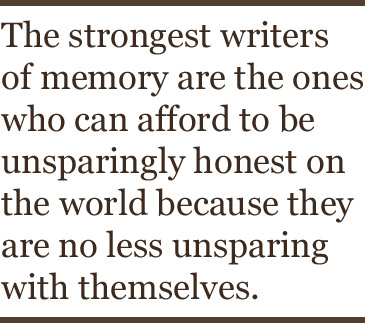
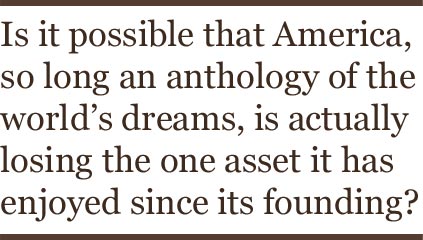 And yet, just recently, a suspicion has begun to arise that, as Yogi Berra immortally put it, the future ain’t what it used to be. The space program, a perfect metaphor for America’s conquest of the future–high technology married to high idealism–plunged to earth with the Columbia. The computer industry, hailed overnight as the solution to all the problems of mankind, proved, inevitably, to be a product of mankind. The once soaring stock market made “futures” a dirty word from which people recoiled, thanks in part to the stabs of terrorism (terrorism’s diabolical logic, of course, being that the future can be undone if the present is unsettled). Even the buildings that once symbolized Manhattan’s forward thrust towards the heavens are gone.
And yet, just recently, a suspicion has begun to arise that, as Yogi Berra immortally put it, the future ain’t what it used to be. The space program, a perfect metaphor for America’s conquest of the future–high technology married to high idealism–plunged to earth with the Columbia. The computer industry, hailed overnight as the solution to all the problems of mankind, proved, inevitably, to be a product of mankind. The once soaring stock market made “futures” a dirty word from which people recoiled, thanks in part to the stabs of terrorism (terrorism’s diabolical logic, of course, being that the future can be undone if the present is unsettled). Even the buildings that once symbolized Manhattan’s forward thrust towards the heavens are gone.